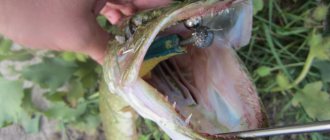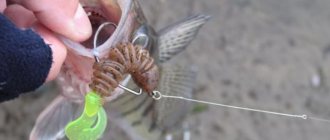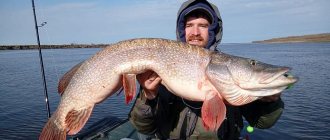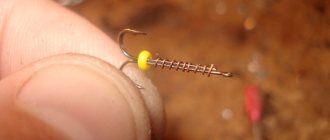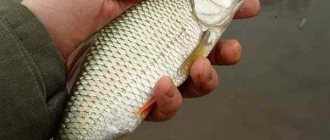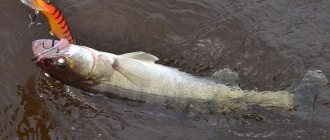What is a jig?
This wiring technique was borrowed from Asian fishermen who used jigs to catch squid. But that was in the recent past and a lot has changed since then, especially the bait. At the moment, all that remains is the wiring technique and its name.
Jig wiring is a torn wiring or wiring in steps. For this fishing technique, the manufacturer produces special jig heads that can be mounted on various silicone baits. In fishing stores you can find twisters, crustaceans, worms, vibrotails, both regular and food-grade rubber.
Spinning - selection criteria
It should be immediately noted that jig heads have their own weight, which can vary from units to tens of grams. Therefore, special requirements are imposed on spinning rods that are incomprehensible to beginning spinners. Spinning is chosen based on 3 main criteria - length, test and sensitivity. With the right choice, the spinner will always feel the bait and react to the bite in time.

Length
The length of the rod is selected depending on the fishing conditions: when fishing from the shore, which does not have serious thickets, a rod up to 3 meters long is suitable. When fishing in places where there are thickets, you won’t catch much with a long rod and it is better to use a shorter rod, for example, 2.4 m long. When fishing from a boat, you can use the shortest rods, and they will be the most effective.
Test
A very important indicator, but for a beginning spinning angler, when he has not yet learned how to cast the tackle correctly, far and accurately, a rod with a weight of up to 45g is suitable. After mastering the jig technique, you can purchase another rod, with a test weight of up to 15g, for using small jig baits.
Sensitivity
The spinning rod must be sensitive, otherwise it will not be possible to react to a bite in time. The components of the sensitivity of a spinning rod are: the structure of the rod and how much the test corresponds to the weight of the jig bait used. If you use small jig baits on rods with a large dough, then you can hardly talk about the sensitivity of such gear, since you won’t even feel the presence of bait on the gear.
Mounting the bait
Select a jig head hook that is the right size for your bait. Many people use double or triple hooks, dreaming of increasing their performance. Such actions lead to additional hooks. Experienced fishermen use a single hook.
There are two main options for mounting bait:
- Rigid mount. Here the lead weight and the hook are rigidly connected. The bait is put on so that the weight is in front, and the open hook comes out from above. When retrieving, the bait plays with its tail, and its body remains motionless.
- Flexible mount. The weight and the hook do not have a rigid connection. Here a “Cheburashka” weight is used, to which the hook is attached using a winding ring. When retrieving, the bait plays not with its tail, but with its whole body. Offset jig hooks are used here, the tip of which is hidden in the bait.
Read more
How to choose a spinning rod for perch fishing
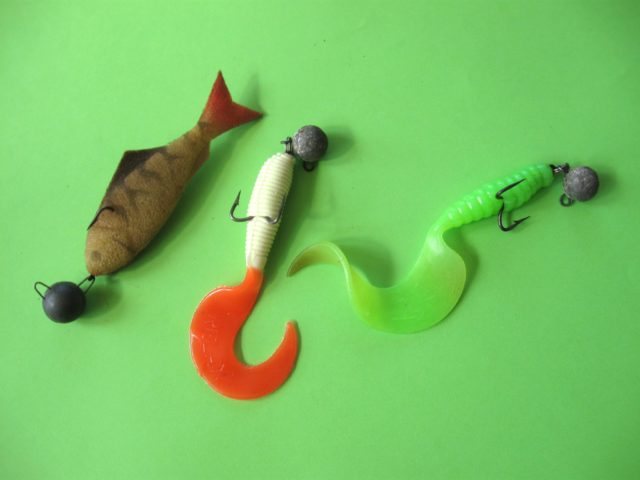
There are two main types of jig baits depending on what material they are made of.
The first option is suitable when using silicone. Foam rubber does not have its own flexibility. Here it is appropriate to use a flexible option.
Coil selection
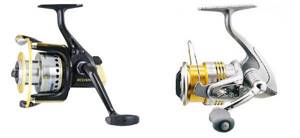
For a beginner, any reel is suitable, but not the simplest and most expensive one. The reel must work well, ensuring the smooth running of the bait, which means that it must have at least 3 bearings. In addition, it must have the following characteristics:
- Durable.
- The presence of a friction brake.
- All elements must be of high quality.
In this case, we are talking about a widespread spinning reel, which is used by almost all spinning players, not to mention beginners. Of course, it is possible to use Soviet inertial ones (and not only Soviet ones), but they are more problematic in this regard.
If we talk about a baitcasting reel, then this is more of an element for professionals and athletes, and catching a huge fish in our time is more of a fantasy than a reality.
Base \"Oasis\" Lace Day. Catching pike perch and pike with a jig...
⌚ — 11 minutes 48 seconds
WHAT EVEN HAPPENED? THE BALANCERS WILL BE BREAKED AND TEARED OFF - winter fishing for pike perch
⌚ — 19 minutes 58 seconds
I have never had such fishing before.. I opened it with a jig. Fishing in February 2021
⌚ — 33 minutes 39 seconds
JIG-RIG ⚠️ BREAKS STEREOTYPES! Fishing in winter on the river 2021. CROSS ON A JIG RIG! PERCH on Jig Rig WIND❗
⌚ — 11 minutes 39 seconds
Winter fishing Kyiv Hydropark Lake Berezka. Perch on a jig
⌚ — 13 minutes 3 seconds
Fishing on the Danube River. There were some surprises.
⌚ — 46 minutes
Perch at the quarry. Fishing.
⌚ — 12 minutes 57 seconds
Asp for trolling. Fishing in August. Kuibyshev Reservoir.
⌚ — 33 minutes 34 seconds
WHAT KIND OF FISH IS THIS?!)))) WRITE IN THE COMMENTS #FISHING #TRENDING #FIRST TOGETHER #TOP
⌚ — 16 seconds
Streetfishing - Brateevo #3. Half-dead bersh, fishing in the cold.
⌚ — 15 minutes 20 seconds
We accidentally found an asp on the Moscow River. Spinning fishing in summer
⌚ — 12 minutes 20 seconds
Jig in February -8 and the wind is TRASH!!!
⌚ — 7 minutes 57 seconds
Fishing with a reelless hook: hook, trophies from a hook./Fishing Asmatico: Hook, Trophies From Hook.
⌚ — 35 minutes 54 seconds
Dnepr Zaporozhye! Feeder fishing on the river
⌚ — 20 minutes 46 seconds
Fishing in the Astrakhan region (Akhtuba River, Selitrennoye village)
⌚ — 6 minutes 44 seconds
Winter fishing 2021, underwater filming, winter pike perch.
⌚ — 8 minutes 25 seconds
Pike-perch on a spinning rod Catching pike-perch on a jig in the fall CRAZY FISH Arion 3 12
⌚ — 7 minutes 54 seconds
Fishing in the Dnieper Delta, Kizomys. 2021. Catching perch from a boat
⌚ — 23 minutes 1 second
Tags:
By dates: 02/15/2021 - 02/16/2021 - 02/17/2021
Commented video:
Let's fall asleep together with Buryonka Dasha - Lullabies. Burenka Dasha! Collection – Songs for children
⇒ “ok” Watch in full... Added - 02/16/2021
Environmental problems
⇒ "normal" Watch in full... Added - 02/16/2021
VIDEO FOR CHILDREN, ZAMANIA 2019
⇒ “My daughters constantly watch such videos.
They also love it when new toys are opened on them. But I’ve never watched them with them, but this time I saw them by accident. You know this is really interesting. There was nothing like this in our childhood, which is a pity. And there wouldn’t be such playrooms...” Watch in full... Added - 02.16.2021 [10 hours] ZELENSKY - GET OUT OF HERE ROBERT
⇒ “cool” Watch in full... Added - 02.16.2021
Lyapik goes to Okido episode 1-10
⇒ “cool” Watch in full... Added - 02/16/2021
Tick-Tsyp - Cartoon for kids - COLLECTION - All episodes in a row.
⇒ “excellent!” View in full... Added - 02/16/2021
Line selection

It should be noted that there are several types of fishing line available for sale. This is the classic widespread monofilament line, the more modern braided line, and fluorocarbon, which is not noticeable to fish in the water. It is very often used for mounting leashes. At the same time, each fishing line has its own advantages and disadvantages. Many spinning anglers prefer cheaper monofilament fishing line. When fishing at short distances, it justifies itself.
When fishing at medium and long distances, it is better to use braided fishing line, as it is more durable with the same thickness. This means that you can take a fishing line with a smaller diameter, which will allow you to cast the bait further.
In addition, it has a low specific stretch, which allows you to effectively transfer bites to the tip of the rod when fishing over long distances.
Using jigs
There are several options for jig bait:
- Silicone ones are quite popular. This is due to the fact that on sale you can find several thousand designs that differ in shape, color, and size.
- Spinner spinners are front-loaded spoons. When free falling, the bait will go to the bottom upside down, which determines the rotation of the spoon.
- Foam rubber is used quite often. This type of bait is quite well known. An example is that previously pike perch were caught exclusively with foam rubber. The special design ensures that the bait does not cling to vegetation, stones, or snags.
- Oscillating spinner and the bait in question are considered by some to be incompatible. But experience suggests the opposite: classic fishing with steps and lowering to the bottom can bring quite a good catch.
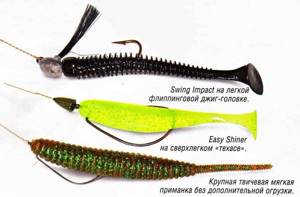
Silicone baits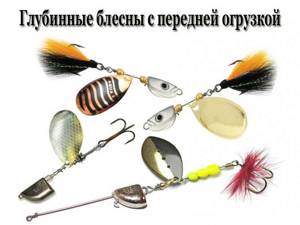
Front loading turntables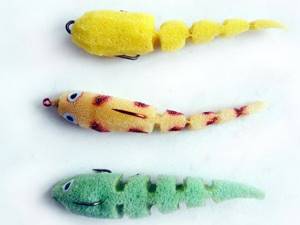
Foam rubber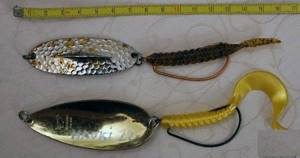
Oscillators
The above information should be taken into account when considering which bait to use.
Bait selection
The following baits are used for jigging:
- Silicone;
- Foam;
- Oscillating spinners.
Silicone baits
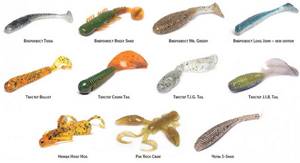
There are other types of baits, for example, wobblers, spinners, but they are not used in jig wiring due to the specific instructions. Rotating spoons work well with even wiring, and wobblers are mostly used depending on specific fishing conditions.
When jig fishing, silicone baits are widely used. The variety of such baits is so great that it’s hard to even imagine. Due to the fact that the construction material has unique characteristics, copies of various insects, animals and fish themselves are made from it. At the same time, there is a large size range, as well as a wide variety of colors.
The choice of bait comes down to the proportion between the fish and the bait itself. To catch pike, you can take a larger bait (7-10 cm long), and for catching perch, a silicone bait measuring 3-5 cm is suitable. As a rule, spinning anglers have several baits of different colors and sizes. The fish is unpredictable and you have to experiment by placing different baits on the spinning rod.
Baits can be attached to tackle in different ways:
- Texas rig. Allows you to catch predators in snags or thickets of aquatic vegetation.
- Caroline. Allows free movement of the bait.
- Moscow. A retractable leash is used.
- Drop shop equipment is a modern equipment for spot fishing.
Oscillators, turntables and foam rubber
For jigging, such baits are not in demand due to their design features. Although, it is quite possible if you use foam fish for jig fishing. They can, to some extent, be compared with silicone ones if the appropriate installation is carried out. Foam rubber baits are mounted both on regular hooks and on doubles, tees or offsets. Lures with offset hooks have excellent qualities. This design allows you to fish snags, as well as places overgrown with aquatic vegetation. When using offsets, you can make baits that are not hooked.
Existing baits
To catch predatory fish using jigs, it is common to use two types of baits: foam rubber and silicone. Which option to choose is an individual decision for everyone. The main thing is that the bait plays beautifully in the water column and meets the fishing conditions. The main differences between silicone and foam rubber are as follows:
- Products made from foam rubber are a kind of “classic of the genre”, which are sold en masse in fishing stores at an affordable price. At the same time, making them with your own hands at home is not at all difficult, which is considered an indisputable advantage. Craftsmen never buy such bait, trying to make something catchy and highly effective with their own hands.
- Silicone baits are especially popular not only among amateurs, but also among more experienced professionals. There are a wide variety of silicone products available for sale in different shapes and colors. Due to the unique properties of the material, it is used to create not only imitation fish, but also all kinds of animals, insects and other representatives of aquatic fauna. To improve the effectiveness of the bait, it is treated with a flavoring agent that increases the frequency of bites. The result is so-called edible rubber.
In addition, you can find combined solutions on the market where both materials are combined. As a rule, these are homemade designs of folk craftsmen who managed to combine silicone and foam products, making something unique. It's no secret that silicone is easily processed at high temperatures, so you don't need to be a special master to turn it into bait. In a short time, you can learn to create real masterpieces that will exceed all expectations and attract even the laziest prey.
Selection of jig heads
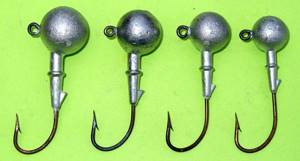
When choosing jig heads you should pay attention to the following points:
- jig head weight;
- shape;
- bait weight.
Jig heads have their own weight, which ranges from 1g to tens of grams.
Small jig heads, weighing from 1g to 4g, are designed for using ultralight baits up to 5cm in size. As a rule, such a tandem catches small perch and other small fish well. To cast such a small bait, you should use a thin fishing line (up to 0.1mm) and an appropriate rod (with a weight of up to 10g). Otherwise, it will be difficult to feel the bait, which will not allow you to play it correctly.
The most popular jig heads weigh from 5 to 20 grams, therefore, a novice spinning fisher should focus on jig heads that are well suited for fishing both in currents and in still water.
When choosing a head of the appropriate weight, you need to pay attention to how quickly it reaches the bottom. If it reaches the bottom in less than 7 seconds, then it is not suitable and you need to take a jig head with a lighter weight. A predator can attack at the moment when the bait smoothly sinks to the bottom or rises sharply from the bottom. To catch fish such as pike perch, baits with a large weight are chosen, since this fish leads a bottom-dwelling lifestyle.
Head shape
Jig heads, depending on their shape, can be divided into 3 types:
- Ball-shaped.
- Iron.
- Rugby.
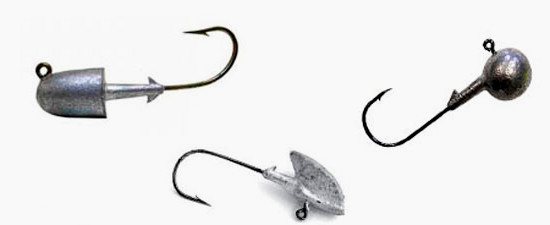
The most common is the spherical shape, which is used by almost all spinning anglers. The only drawback of this form is that it falls to one side when reaching the bottom, but it can always be purchased at the store.
The iron-on shape and rugby shape are free of such problems, but they are difficult to find in the retail chain due to low demand.
As practice shows, the shape of the sinker has little effect on fishing performance. Here, special attention should be paid to the wiring technique, and you can master this technique perfectly if you have the appropriate fishing rod.
Suitable reel
Unlike other types of spinning fishing, jig fishing does not require a long selection of additional devices, including a reel. In this case, conventional spinning reels with suitable size and performance characteristics are used. Old multipliers are used less often, although due to the difficulties of setting them up, only experienced craftsmen with the “old school” like them.
Nevertheless, when fishing for large prey, a multiplier tool can become indispensable. As an example, we can take the “mustached” inhabitant of the depths - the catfish, which grows up to several tens of kilograms. For other trophies, ordinary inertia-free models are quite suitable, which are much easier to control and at the same time withstand impressive loads.
Both amateurs and sports fishing professionals prefer spinning reels with a special spool coating. If braid is used as a working line, then a plastic spool is not the best choice. Due to the abrasive properties of braided cord, if it comes into contact with such material, it will wear out and become unusable.
Such requirements are not imposed on ordinary monofilament products.
Jig fishing technique for beginners

Jig involves a stepped wiring technique, therefore, especially for beginners, it makes sense to dwell in more detail on the step. The entire wiring technique includes several stages:
- Casting tackle.
- Waiting until the bait sinks to the bottom. This moment is recorded by the sagging of the fishing line.
- Install the spinning rod at an angle of 45 degrees and make 3-5 turns of the reel.
- There is a pause until the bait sinks to the bottom again.
An angle of 45 degrees is necessary for effective hooking. While retrieving, you can make short movements with the rod, helping the bait play. As a rule, bites occur during pauses when the bait slowly sinks to the bottom. At this moment, you need to keep an eye on the tip of the rod, to which the moment of biting will be transmitted. As soon as a bite occurs, you should immediately hook it. The hook should be sharp and short, without large amplitude movements. And then it’s a matter of technology. For a beginning spinning player, this can be a difficult task, especially under difficult fishing conditions (uneven shore, thickets, etc.). Therefore, it is recommended to have a landing net with you, which will simplify the process of landing fish.
Wires for jig fishing
To get good results, use a variety of wiring. After all, there is no universal solution suitable for any situation.
There are five main types of wiring:
- Aggressive. Here the bait should rise sharply over a short distance and slowly fall.
- Stepped. This type of wiring involves raising the rod to a vertical position in several jerks.
- Wiring for demolition. A small jig head is pulled along the bottom by the current.
- Bouncing. Lethargic fish are attracted by the animation of the bait. She is twitched in such a way that she makes small jumps on the bottom.
- Uniform wiring. This option is used when fishing in medium water. To improve results, use heads equipped with a rotating blade.
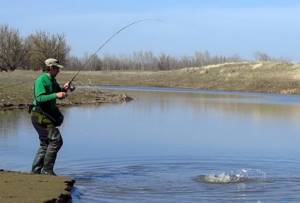
. Types of rigs:
- "Texas". Here an offset and a weight are used, the shape of which resembles a bullet. The bait is presented in the form of a worm. The sinker has the ability to slide. Slowly lowering such a bait often results in bites.
- "Caroline". A bullet-shaped weight is installed at a distance from the bait. When retrieved, it drags along the bottom, creating an attractive cloudy cloud. The bait in the form of a worm is not attached to the load, and is distinguished by its characteristic game.
- "Dropshot". The offset hook is installed above the weight on the main fishing line. It is tied in such a way that it is always at an angle of 90 degrees.
- Retractable leash. The offset hook is attached to a pull-out leash mounted on a swivel.
- "Cheburashka" This is the name of the weight, to one eye of which an offset hook is attached. There are rigs that provide for attaching a double hook to the Cheburashka.
- Front hook. This equipment for jig fishing involves installing a hook in front of the bait. A spiral with a ring for putting on a hook is screwed into it. This installation of jig equipment increases the passage through grass, snags, and aquatic vegetation.
- Equipment with float. This option is used when wiring at a certain depth. The lightweight bait is equipped with a float. He doesn't let her drown. Often the float is replaced with a floating wobbler.
- Drifting bottom tackle is used when fishing in the current. Here a layering with a load is made. It is located at a distance of up to 50 cm from the bait.
- "Petty tyrant". A weight is attached to the end of the main line. Several leashes with hooks at a certain distance are tied above. This jig rig is suitable for fishing at great depths.
- Pike rig. Its main difference is the use of a metal leash. The sharp teeth of the pike cut fishing line and braided cord. To maintain the jig rig for pike, use a special leash. Its length reaches 20 cm. When using a jig for large pike, use long leashes.
Read more
Which reel to choose for a float fishing rod?
